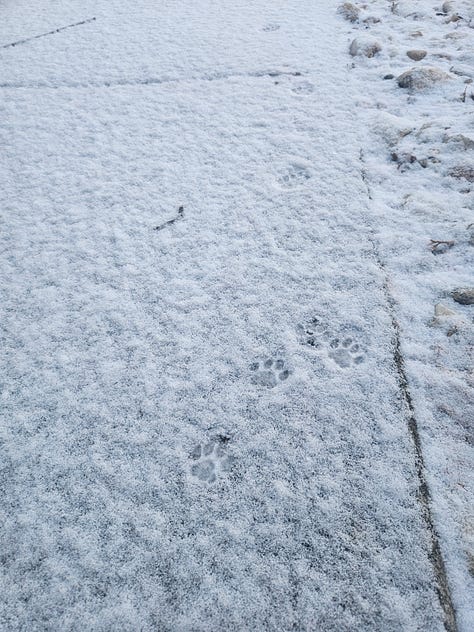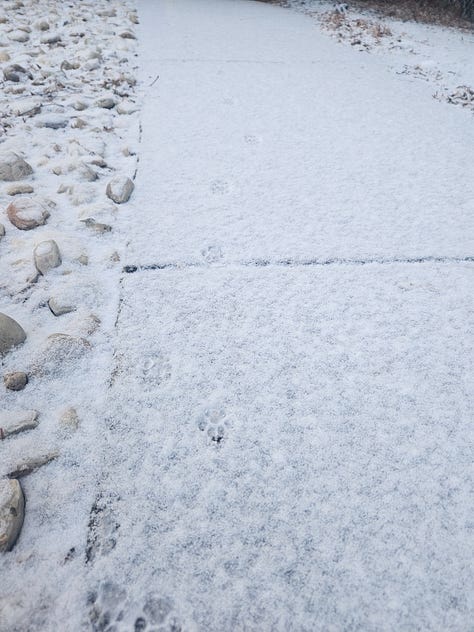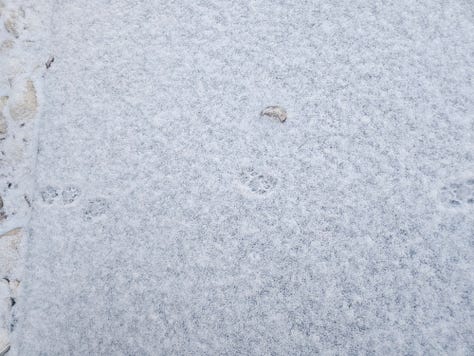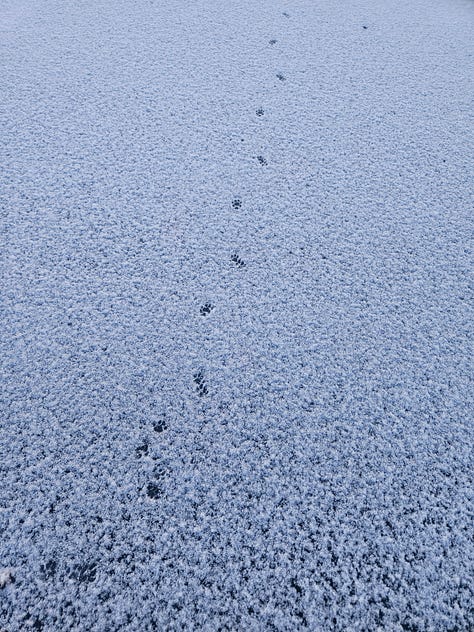The Snow Gave Me Paws






What did the werewolf poet say? The Moon gave me paws.
We were dusted by snow again the other morning, and as I salted the walk with calcium chloride, I found a story. Last week, I shared with you Tom Brown Jr’s lesson that every track is a story, and how my friend Suzanne and I followed fox tracks into a morning’s past when we encountered their maker on a hike; I shared how snow reveals hidden stories all around us.
This cat’s tale was no different. I’ve found groundhogs, gray squirrels, red foxes, chipmunks, and striped skunks in our yard; we don’t have much greenery, with the pool and the shed, but they use our yard as one go-through from Timber Creek to a patch of woods along the road. I don’t try to stop them, either. We lost some iris bulbs to the big mama skunk—who also came to visit us one night while we were in the hot tub—but we try to get along. When we had Louie cat, he got friendly with a skunk kit, sniffing each other curiously, and only got sprayed when I barged into the yard not knowing that the skunk was there. The groundhog fell in the pool but found his way out before we could get him with the skimmer.
But I didn’t know we had any outdoor cats in the neighborhood. This one entered through the carport, which has the woodpile that a red fox once used to shelter from a thunderstorm; the cat then slunk under the gate, and padded over the patio, along the garden with its frozen lavender and hostia, ignored the bird feeder, and exited through a gap in the fence that’s no longer plugged, since Louie died this summer. Then the cat walked over my front lawn and crossed the street to visit my neighbor. Perhaps she was looking for birds or chipmunks, or to smell the spots where Louie marked the yard, wondering where he’s been.
You can see from the photos that the prints were relatively fresh. This was just after sunrise, on a calm and cold day. How am I so sure they’re housecats? They’re round, in a direct register, without claw marks, and maybe an inch wide. Bobcats are rare in these parts, and have larger paws. I’d love to see one, but I think I’d have to venture north.
I’ve been feeding a lot of starlings this year, because a rising tide raises all boats. And occasionally, I get a Red-Bellied Woodpecker or a Blue Jay at the feeder. These two videos are from one minute at the feeder; the woodpecker chases off a starling, and then a Blue Jay drops in:
The Blue Jay:
“If a lion could speak, we could not understand him.”—Ludwig Wittgenstein
I like to think of myself as a follower of science, but on occasion, I have to part ways with some of the dogma. Particularly, how they will ignore their own eyes to avoid engaging in “anthropomorphism.” No, I do not believe animals “think” the same way we do; but I think it is obvious to anyone who has observed them that they have individual personalities, and express some emotions in a similar way that humans do, especially grief. I think we try to distance ourselves from animals so we can be cruel to them and assuage our guilt.
I can understand why scientists, when studying animals in the wild, want to refer to them as Subject A and not “Fred,” so they can be objective. But pretending that Subject A and Subject B have no personalities when you have observed individual behaviors is, to me, as delusional as a religious leader refusing to believe the Earth revolves around the sun because a book said so. This piece on animal grief by Carl Safina should convince anyone that many non-human species grieve. The supremacy of humans is one of our great failings. We are certainly special, but in many ways, we are nothing special. And to think we have a monopoly on emotions is arrogance to the point of stupidity.
If you haven’t been following Charlie Hamilton James’s memoir, in this entry, he meets Giant Otters on the Amazon!
More otters:
One of the first books I fell in love with as a child was Strange Companion: A Story of Survival by Dayton O. Hyde. This book and Ronald Reagan’s demented nuclear brinksmanship turned me into a young survivalist, eating rose hips from my grandmother’s garden and learning archery so we could eat mutant deer after the apocalypse. It also helped make me a budding naturalist, who read all 400 pages of the Reader’s Digest guide to North American Wildlife over and over. Strange Companion is about a young boy flying into the Alaskan interior with a guide to meet his father; their plane crashes and the boy has to survive on his own after the guide is kicked to death by a moose. His only companion is a Whooping Crane, who follows him for some reason. It’s been forty years since I read it, but it made me appreciate these giant birds, and I am glad that we have saved them from the brink of extinction. Bill David reminded me of them with this week’s post:
I planned on visiting the shore to look for waterfowl, but the weather turned. We’re in for a cold snap, single digits Fahrenheit for the next few days. I’ll probably hole up indoors with books. Right now I’m reading several, these included:
Shadows on the Rock, by Willa Cather, set in colonial Quebec.
Crash Course: From the Good War to the Forever War, by my old professor, H. Bruce Franklin. A memoir and condensation of American history during his lifetime.
The Night Country, by Loren Eiseley. One of the poet-paleontologist’s later works, as he looks back on a long life of bone-hunting and exploring nature.
Hayao Miyazaki, by Jessica Neibel. A retrospective of his work, filled with gorgeous art.





